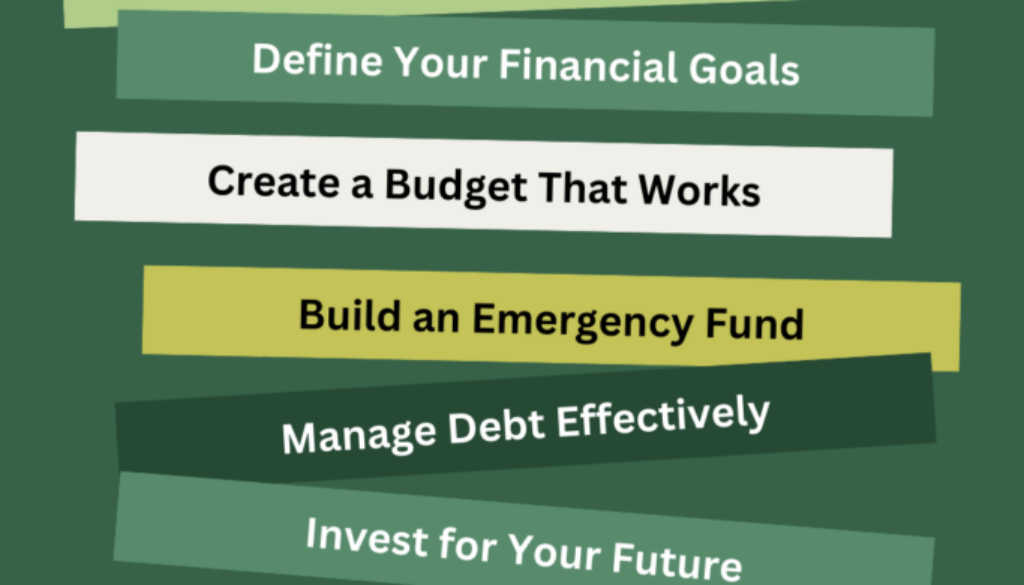A Step-by-Step Guide to Creating a Personal Financial Plan
A solid financial plan is the foundation of long-term wealth and financial security. Whether you’re just starting or looking to refine your existing financial strategy, having a well-structured plan ensures you stay on track toward your financial goals. Without a clear roadmap, managing money can feel overwhelming, leading to financial stress and missed opportunities for growth. In this guide, we will walk you through a step-by-step process to create a personal financial plan that works for you, helping you take control of your financial future with confidence.
Step 1: Assess Your Current Financial Situation
Before making any financial plans, you must first understand where you currently stand. This step involves gathering information about your income, expenses, assets, and liabilities. By analyzing your current financial situation, you can identify areas for improvement and set a realistic foundation for your financial goals.
1.1 Understanding Your Net Worth
Your net worth is a snapshot of your financial health. It is calculated by subtracting your liabilities (debts) from your assets (savings, investments, and property). If your assets exceed your liabilities, you have a positive net worth, which is a good sign of financial stability. If your liabilities surpass your assets, it may indicate financial trouble that requires strategic action. Understanding your net worth helps you measure progress over time and make informed financial decisions.
To calculate your net worth, create two lists: one for assets and one for liabilities. Include everything of value, such as:
- Bank account balances
- Retirement savings (401k, IRA)
- Investments (stocks, bonds, real estate)
- Owned vehicles and properties
Liabilities include:
- Credit card balances
- Student loans
- Mortgages
- Car loans Subtract liabilities from assets, and review this number annually to track financial progress.

1.2 Tracking Your Income and Expenses
A budget isn’t just about cutting costs—it’s about knowing where your money goes. Start by tracking all income sources, including your salary, side hustles, and passive income. Then, list all your expenses, including rent, groceries, utilities, debt payments, and entertainment. This process helps you identify spending patterns, uncover unnecessary expenses, and allocate money efficiently. Using apps like Mint or YNAB can simplify this process.
To categorize expenses, break them down into:
- Fixed expenses: Rent/mortgage, insurance, loan payments
- Variable expenses: Groceries, transportation, entertainment
- Discretionary expenses: Dining out, vacations, shopping
Once categorized, compare your income to expenses to determine if adjustments are needed to save or invest more effectively.
1.3 Analyzing Debt and Liabilities
High-interest debt can hinder financial progress. Make a list of your outstanding debts, including credit cards, student loans, mortgages, and car loans, along with their interest rates. Understanding your debt obligations allows you to develop a strategy to pay them off effectively and avoid financial strain.
To manage debt, consider:
- Debt snowball method: Pay off the smallest debt first for quick wins.
- Debt avalanche method: Pay off the highest interest rate debt first to save money.
- Debt consolidation: Combine multiple debts into one with a lower interest rate.
A strong debt repayment strategy ensures financial freedom and improves credit scores over time.
*Step 2: Define Your Financial Goals
Setting clear financial goals gives you a roadmap to follow. Your goals should be SMART: Specific, Measurable, Achievable, Relevant, and Time-bound. By defining clear objectives, you can create a financial strategy that aligns with your personal aspirations and lifestyle. Without well-defined goals, it becomes difficult to measure success and maintain motivation.
2.1 Short-Term vs. Long-Term Goals
Short-term goals, like building an emergency fund or paying off a credit card, differ from long-term goals, such as saving for retirement or purchasing a home. Recognizing these distinctions helps you allocate resources wisely and maintain focus on what matters most. Short-term goals generally require immediate action and can be achieved within a few months to a couple of years, while long-term goals span multiple years and require consistent effort.
Short-term goals may include:
- Paying off credit card debt
- Building a three-month emergency fund
- Saving for a vacation
- Purchasing a new laptop or phone
Long-term goals, on the other hand, may include:
- Buying a home
- Retiring comfortably
- Funding your child’s college education
- Growing your investment portfolio
Understanding the timeline of each goal allows you to prioritize and create an effective action plan.
2.2 Prioritizing Financial Objectives
Not all goals can be achieved at once. Rank them based on urgency and importance. For example, paying off high-interest debt should take priority over saving for a vacation. This approach ensures that you make steady progress without feeling overwhelmed.
To prioritize effectively, consider the following factors:
- Financial Impact: Will achieving this goal significantly improve your financial situation? Paying off high-interest debt, for example, can free up more income for future savings and investments.
- Time Sensitivity: Is this goal time-sensitive? If you plan to buy a home in five years, you need to start saving early.
- Personal Values: Does this goal align with your lifestyle and future vision? For some, early retirement is a priority, while others may focus on travel or philanthropy.
- Available Resources: Do you have the resources to start working toward this goal immediately? Some goals require an initial financial commitment, while others can be pursued gradually.
Once you prioritize your goals, break them down into actionable steps. For instance, if your goal is to save $20,000 for a down payment on a home within five years, you should aim to save $4,000 per year or approximately $333 per month. Tracking progress along the way ensures that you stay motivated and make necessary adjustments as life changes.
A well-structured financial plan aligns your financial goals with your daily spending and savings habits, ensuring you stay on track toward financial independence.
Step 3: Create a Budget That Works
Budgeting is about taking control of your money rather than letting it control you. A well-structured budget ensures you allocate funds toward your goals while covering necessary expenses.
3.1 The 50/30/20 Budgeting Rule
One of the most popular budgeting frameworks is the 50/30/20 rule—50% for needs, 30% for wants, and 20% for savings and debt repayment. This simple yet effective approach helps maintain a balanced financial lifestyle. However, individual circumstances may require adjustments to these percentages to better fit personal financial situations.
3.2 Zero-Based Budgeting and Other Methods
If the 50/30/20 rule doesn’t fit your lifestyle, consider zero-based budgeting, where every dollar is assigned a job before the month begins. Other approaches, like envelope budgeting, can help those who prefer cash-based spending management.
Additional budgeting techniques include:
- Pay-yourself-first method: Save and invest a fixed amount before spending on other expenses.
- Percentage-based budgeting: Allocate income percentages based on personal priorities.
- Reverse budgeting: Determine savings goals first and allocate remaining funds toward expenses.
Choosing the right budgeting method depends on financial habits, discipline, and goals.
3.3 Adjusting Your Budget Over Time
A budget is not static—it should evolve with life changes, income fluctuations, and financial priorities. Regularly reviewing and adjusting your budget ensures you stay on track.
To keep your budget effective:
- Review spending habits monthly and adjust categories as needed.
- Increase savings contributions as income grows.
- Cut back on unnecessary expenses to reallocate funds toward high-priority goals.
- Account for inflation and cost-of-living changes over time.
An adaptive budget keeps your financial plan relevant, ensuring long-term success.
Step 4: Build an Emergency Fund
An emergency fund acts as a financial safety net, preventing debt accumulation when unexpected expenses arise.
4.1 How Much Should You Save?
Experts recommend saving 3 to 6 months’ worth of living expenses, but the right amount depends on your job stability and personal circumstances. If you have dependents or an irregular income, consider saving more.
To determine your target amount, calculate essential monthly expenses, including rent, groceries, utilities, insurance, and transportation. Multiply this by the number of months you want to cover.
4.2 Where to Keep Your Emergency Fund
Your emergency fund should be easily accessible but separate from your everyday spending account. Consider placing it in:
- High-yield savings accounts for liquidity and interest growth.
- Money market accounts with competitive interest rates.
- Certificates of deposit (CDs) if you don’t need immediate access.
Keeping funds separate ensures you don’t use them for non-emergency expenses, providing true financial security.
Step 5: Manage Debt Effectively
Debt management is a crucial part of any financial plan. Carrying high-interest debt can impede your financial progress, while strategic debt management can improve your credit score and free up income for savings and investments.
5.1 Understanding Different Types of Debt
Debt falls into two categories:
- Good debt: Includes mortgages, student loans, and business loans that have the potential to generate long-term value.
- Bad debt: Includes high-interest credit cards and payday loans, which can quickly spiral out of control.
5.2 Strategies for Paying Off Debt
- Debt snowball method: Focus on the smallest balance first, then move to the next.
- Debt avalanche method: Pay off the highest interest rate debt first to minimize costs.
- Balance transfers and refinancing: Reduce interest rates to accelerate repayment.
- Debt consolidation: Combine debts into a single loan with a lower interest rate.
5.3 Avoiding Future Debt
- Limit unnecessary credit card usage.
- Build an emergency fund to avoid reliance on credit.
- Use cash or debit for everyday purchases.
By effectively managing debt, you can achieve financial stability and long-term success.
Step 6: Invest for Your Future
Investing is essential for building long-term wealth and achieving financial independence. By allocating money into investment vehicles, you can grow your wealth over time and outpace inflation. Understanding different investment options and strategies helps you make informed decisions.
6.1 Understanding Different Investment Options
Investments come in various forms, each with its own level of risk and potential return. Some common investment options include:
- Stocks: Ownership in a company that provides growth potential and dividends.
- Bonds: Loans to corporations or governments that pay interest over time.
- Mutual Funds & ETFs: Diversified portfolios managed by professionals.
- Real Estate: Physical property investments that generate rental income and appreciate over time.
- Alternative Investments: Includes commodities, cryptocurrencies, and private equity.
6.2 Retirement Accounts and Wealth-Building
Planning for retirement ensures financial security in later years. Consider contributing to:
- 401(k): Employer-sponsored plans with tax advantages.
- IRA (Traditional or Roth): Individual retirement accounts with different tax treatments.
- Pension Plans: Employer-provided retirement income for eligible workers.
- Annuities: Long-term financial contracts that provide steady income in retirement.
By investing early and consistently, you maximize compound interest and build substantial wealth over time.
6.3 Managing Risk and Asset Allocation
Investing involves risk, but diversification helps mitigate potential losses. Consider:
- Asset Allocation: Spreading investments across different asset classes (stocks, bonds, real estate) to balance risk and reward.
- Diversification: Investing in multiple sectors and industries to avoid overexposure to a single market segment.
- Risk Tolerance Assessment: Understanding how much risk you can afford based on financial goals and time horizon.
Regularly reviewing and rebalancing your portfolio ensures it aligns with your risk tolerance and long-term objectives. By making strategic investments and adapting to market changes, you can achieve financial security and grow wealth effectively.
Step 7: Protect Your Financial Future
Building wealth is important, but protecting it is just as crucial. Without proper safeguards in place, unexpected events such as illness, job loss, or economic downturns can jeopardize your financial security. Protecting your financial future involves having the right insurance policies, legal documents, and risk management strategies to ensure long-term stability.
7.1 The Importance of Insurance
Insurance is a vital component of financial planning as it provides financial security against unforeseen risks. Some essential types of insurance include:
- Health Insurance: Covers medical expenses and protects against high healthcare costs.
- Life Insurance: Provides financial support for dependents in the event of your passing.
- Disability Insurance: Replaces a portion of your income if you become unable to work due to illness or injury.
- Homeowners/Renters Insurance: Protects your property and belongings from damage or theft.
- Auto Insurance: Covers vehicle-related accidents and liabilities.
- Long-Term Care Insurance: Helps cover the costs of extended healthcare services, such as nursing homes or in-home care.
Having adequate coverage ensures that unexpected events do not lead to financial ruin.
7.2 Estate Planning and Legal Protections
Estate planning helps secure your assets and ensures they are distributed according to your wishes. Key elements of estate planning include:
- Will: A legal document outlining how your assets should be distributed after your death.
- Trusts: Legal entities that hold assets for beneficiaries and help avoid probate.
- Power of Attorney: Grants someone the authority to manage your financial affairs if you become incapacitated.
- Living Will & Healthcare Proxy: Specifies medical treatment preferences and designates someone to make healthcare decisions on your behalf.
Regularly reviewing and updating these documents is crucial to keeping your estate plan aligned with your evolving financial and personal situation.
7.3 Emergency Fund and Risk Management
Having an emergency fund is one of the simplest yet most effective ways to protect your financial future. A well-funded emergency account allows you to cover unexpected expenses, such as:
- Job loss
- Medical emergencies
- Major car or home repairs
Experts recommend saving at least 3 to 6 months’ worth of essential living expenses in a high-yield savings account for easy access.
Risk management also involves diversification of assets, maintaining a well-balanced investment portfolio, and ensuring you are not overly reliant on one income source. Spreading investments across different asset classes and industries helps mitigate financial shocks from market downturns.
7.4 Identity Theft and Fraud Protection
In today’s digital world, identity theft and financial fraud are significant risks. Protect yourself by:
- Monitoring credit reports regularly.
- Using strong, unique passwords for financial accounts.
- Enabling two-factor authentication on banking and investment accounts.
- Avoiding public Wi-Fi when accessing sensitive financial information.
- Freezing your credit if you suspect fraudulent activity.
By implementing these protective measures, you can safeguard your financial future from both physical and digital threats.
Step 8: Monitor and Adjust Your Financial Plan
A financial plan is not static; it should evolve with life changes and financial goals. Regularly reviewing and adjusting your plan ensures that you stay on track and make necessary modifications to adapt to new circumstances.
8.1 Conducting Regular Financial Check-Ups
To maintain financial health, conduct financial check-ups at least once every quarter. These reviews should include:
- Evaluating your income and expenses to ensure you are staying within budget.
- Reviewing savings and investment growth to confirm you are on track with your financial goals.
- Checking credit reports and scores to identify any discrepancies or potential fraud.
- Assessing debt repayment progress and making necessary adjustments to accelerate payoff.
- Examining insurance coverage to ensure adequate protection against unforeseen risks.
By routinely assessing your financial health, you can identify areas for improvement and make informed adjustments as needed.
8.2 Adapting to Life Changes
Life is unpredictable, and major changes can have significant financial implications. Be prepared to update your financial plan in response to:
- Career Changes: A promotion, job loss, or career switch may require budget modifications and reassessment of savings strategies.
- Marriage or Divorce: Combining or separating finances impacts savings, expenses, and long-term financial goals.
- Having Children: Increased expenses for childcare, education savings, and insurance coverage adjustments may be necessary.
- Buying or Selling a Home: Mortgage payments, property taxes, and maintenance costs should be factored into your budget.
- Retirement Planning Adjustments: As you get closer to retirement, asset allocation and withdrawal strategies may need reevaluation.
8.3 Utilizing Financial Advisors and Tools
Sometimes, managing financial changes requires expert guidance. Consider consulting with a financial advisor to:
- Develop or revise investment strategies.
- Optimize tax planning and retirement savings.
- Navigate major financial decisions, such as estate planning and wealth transfer.
Additionally, leverage financial tracking tools and budgeting apps to automate monitoring and make informed decisions efficiently.
By staying proactive and regularly adjusting your financial plan, you ensure that your financial goals remain achievable regardless of life’s inevitable changes.
Final Thoughts: Your Path to Financial Success
Creating a personal financial plan is one of the most empowering steps you can take toward financial freedom. By following these steps, you can build a roadmap that leads to stability, security, and long-term wealth. The key is consistency—stay committed, track your progress, and make adjustments along the way. With a proactive approach, financial success is within reach.





